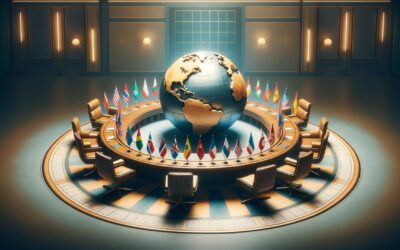Dive into the realm of effective communication in conflict resolution with English Plus Podcast. Join Danny in exploring how dialogues can bridge divides and foster global harmony in our 24-step journey towards peace.
Audio Episode
Interactive Transcript
You can enjoy listening and watching the words you’re listening to with the additional functionalities the interactive transcript offer you, like searching for words and jumping to a specific segment and more. Try the new way of interactively listening to the episode for more engagement and learning with English Plus Podcast.
Episode Transcript
Part 1: Dialogues Across Divides
Welcome to another episode of the English Plus Podcast. I’m your host, Danny, and today, we’re embarking on a significant step in our series, “Peace by Peace: A 24-Step Journey to Global Harmony.” Our focus today is on “Dialogues Across Divides: The Power of Communication in Conflict Resolution.
Communication is the cornerstone of human interaction. It’s the thread that weaves through the fabric of our relationships, holding together families, communities, and nations. Yet, when conflicts arise, as they inevitably do, communication often takes the first hit. Misunderstandings, harsh words, or the deafening silence of a cold shoulder can quickly escalate tensions. But what if I told you that the very thing that often breaks down during conflicts, communication, can be the key to resolving them?
Let’s start with a fundamental truth: conflict is not inherently bad. That’s right; conflicts can be healthy and even necessary for growth. They challenge our perspectives, reveal underlying issues, and can lead to constructive change. However, the way we handle these conflicts makes all the difference. That’s where dialogue comes in – not just any dialogue, but effective, empathetic, and constructive communication.
Firstly, let’s debunk a common myth. There’s this idea that for a conversation to be effective in conflict resolution, both parties need to be calm, rational, and unemotional. While remaining calm can be helpful, we’re human beings, not robots! Emotions are a natural part of our experiences, especially in conflicts. The key is not to eliminate emotions but to understand and manage them. This means acknowledging your feelings and those of the other person. Remember, it’s okay to say, “I’m really upset about this,” and it’s equally important to allow the other person to express their emotions.
Now, onto the art of listening – and I mean really listening. It’s not just about waiting for your turn to speak or formulating your rebuttal while the other person is talking. Active listening involves fully concentrating on what’s being said, understanding it, responding appropriately, and remembering the key points. It’s like trying to listen to your favorite song in a noisy room; you have to tune out the distractions to really hear the melody and lyrics.
Here’s where it gets interesting. In conflict resolution, active listening serves a dual purpose. Firstly, it helps you understand the other person’s perspective, which might differ significantly from your own. Secondly, it shows respect and validation for their feelings and viewpoints, even if you don’t agree with them. This doesn’t mean you have to change your stance, but acknowledging the validity of another person’s feelings can be a powerful step towards resolution.
Now, let’s talk about language – after all, this is the English Plus Podcast! The words we choose in conflict situations carry immense weight. Certain phrases can escalate a situation, while others can help de-escalate it. For example, using “I” statements like “I feel” or “I think” rather than “you” statements (like “You always” or “You never”) can express your feelings without sounding accusatory. It’s like saying, “I’m on my own team, but I’m not necessarily against yours.”
Humor me for a moment and consider the power of a well-timed pause. Silence can be golden in a heated discussion. It gives everyone a chance to breathe, process what’s been said, and collect their thoughts. Sometimes, in the heat of the moment, we’re like popcorn in a hot pan, ready to explode. A pause can be that moment of taking the pan off the heat.
Now, let’s touch on empathy – the ability to put yourself in someone else’s shoes. It’s like trying to read a book in a language you’re not fluent in; you might not understand everything perfectly, but you can get the gist of the story. Empathy in communication means trying to understand the other person’s perspective, feelings, and motivations, even if they differ from your own.
What about when dialogues get tough, and tensions run high? This is where de-escalation strategies come into play. De-escalation is about lowering the intensity of a confrontation. It’s like turning down the heat under a pot that’s about to boil over. It involves things like acknowledging the other person’s feelings, using a calm and steady tone, or even agreeing to take a break and revisit the conversation later.
But let’s not forget the role of cultural awareness and sensitivity. Communication styles vary vastly across cultures. What’s considered a straightforward and honest approach in one culture might be seen as rude and aggressive in another. It’s like trying to use an electrical appliance from one country in another without an adapter; the results can be, well, shocking. In cross-cultural conflicts, taking the time to understand and respect these differences is crucial.
Moving towards a resolution doesn’t always mean finding a middle ground or one party giving in. Sometimes, it’s about agreeing to disagree but doing so respectfully. It’s like realizing that you both like different genres of music; you don’t have to start loving their playlist, but you can appreciate their right to choose it.
Finally, let’s talk about the aftermath. Effective communication in conflict resolution isn’t just about the immediate issue; it’s about building a foundation for better future interactions. It’s about leaving the door open for ongoing dialogue, understanding, and growth.
In conclusion, dialogues across divides, especially in times of conflict, require patience, understanding, and a genuine commitment to resolving issues constructively. As we journey through our series “Peace by Peace,” it becomes increasingly clear that communication isn’t just a tool for conflict resolution; it’s the very essence of building lasting peace and harmony.
So, next time you find yourself in a conflict, remember the power of words, the art of listening, the grace of empathy, and the strength of mutual respect. These are the building blocks for not just resolving conflicts, but for creating a more peaceful and understanding world.
Well, that was just the beginning of our conversation today. We still have a lot to cover from keywords, key takeaways, action points, commonly asked questions and more. Next, because words matter when it comes to our discussions about peace, we’re going to focus on some keywords we should learn from our topic for today in our Peace by Peace episode, dialogues across divides. That’s coming next. Don’t go anywhere; I’ll be right back.
Part 2: Keywords and Takeaways
And now let’s dive deeper into some important keywords and phrases from our discussion on “Dialogues Across Divides: The Power of Communication in Conflict Resolution.” We’ll explore their meanings both in the context of our topic and as standalone vocabulary for those keen on enhancing their English proficiency.
Let’s begin with ‘conflict resolution.’ This term not only implies the process of resolving a dispute or a conflict but in a broader sense, represents the methods and processes involved in facilitating the peaceful ending of conflict. Think of it as the art of finding a peaceful solution to a disagreement.
Next is ’empathy,’ a key element in conflict resolution. Empathy means the ability to understand and share the feelings of another. In the context of our discussion, it involves stepping into someone else’s shoes to understand their perspective, which can be crucial in resolving conflicts.
‘Dialogue’ is another vital term. It’s more than just conversation; it’s an exchange of ideas or opinions to reach a better understanding. In the context of our discussion, dialogue is the tool through which conflicts can be addressed and resolved.
Active listening’ takes our understanding of listening to a higher level. It’s not just hearing the words but also understanding, engaging, and responding to them. In conflict situations, active listening can be a powerful tool to ensure that all parties feel heard and understood.
Then we have ‘constructive communication.’ This phrase is about exchanging ideas and messages in a way that is positive and helpful, especially in solving problems or resolving disagreements. Constructive communication is key in conflict resolution as it helps keep the conversation focused on finding solutions.
‘Misunderstandings’ are common in conflict. These occur when there’s a failure to understand something correctly. Clearing up misunderstandings can often lead to resolving the conflict.
‘Validation’ in communication means acknowledging and accepting another person’s feelings and viewpoints. It’s an important aspect of resolving conflicts, as it helps in building mutual respect and understanding.
‘De-escalation’ is about reducing the intensity of a conflict. It’s like turning down the heat in a heated argument, making it easier to find a common ground.
‘Cultural awareness,’ especially in communication, refers to the understanding of how cultural differences can affect communication and interaction. This is crucial in conflict resolution as it helps avoid cultural misunderstandings that could escalate conflicts.
Lastly, the term ‘agreeing to disagree’ is about acknowledging that it’s okay to have different opinions and that these differences don’t necessarily have to result in ongoing conflict. It’s a form of resolution where both parties accept their differences but choose to move forward respectfully.
From these terms, several key takeaways emerge. Conflict is not inherently negative; it’s a part of human interaction that can lead to growth and understanding if handled correctly. Effective communication, which includes active listening, empathy, and constructive dialogue, plays a crucial role in resolving conflicts. Emotions are an integral part of this process, and managing them effectively can lead to better understanding and resolution. Understanding and respecting cultural differences are also vital in this process. Finally, conflict resolution does not always mean finding complete agreement but can also be about respectfully acknowledging and managing differences.
Each of these concepts plays a significant role in understanding and applying the principles of conflict resolution. They remind us that communication is not just about the exchange of words but about understanding, respect, empathy, and the willingness to see beyond our own perspectives. In sum, mastering these concepts and integrating them into our interactions can lead us to more effective conflict resolution and contribute to building a more harmonious and understanding world.
And now that we have covered the keywords mentioned in our discussion, let’s turn our attention to some action points we can consider in the next segment of our episode today. That’s coming next, so don’t go anywhere; I’ll be right back.
Part 3: Take Action
In our journey through “Dialogues Across Divides,” we’ve explored the intricate dance of communication in conflict resolution. Let’s now turn this understanding into actionable insights and lessons, shaping our approach to conflict and communication.
First and foremost, embracing empathy emerges as a fundamental lesson. The ability to understand and share the feelings of another isn’t just a soft skill; it’s a critical tool in our conflict resolution toolkit. It involves a conscious effort to step into the shoes of others, especially when our natural inclination might be to stand firm in our own perspective. Empathy, in this sense, becomes a bridge over the chasm of misunderstanding.
Active listening, then, is the companion to empathy. It requires us to not only hear but truly listen to what is being said, and, more importantly, what is left unsaid. This involves setting aside our own preconceptions and listening with the intent to understand, not to respond. Think of active listening as a form of respect, a way of saying, “Your perspective matters.”
Constructive communication is another critical action point. This means choosing our words wisely, being aware of our tone, and framing our messages in a way that fosters understanding rather than defensiveness. It’s about steering the conversation away from blame and towards understanding and resolution. Constructive communication is like a carefully navigated river; it requires constant attention and adjustment to ensure it flows in the right direction.
Understanding the importance of de-escalation is also vital. In the heat of conflict, it’s easy for emotions to boil over. Learning to recognize these moments and actively working to lower the intensity is crucial. This might involve taking a break, changing the subject, or simply agreeing to revisit the issue once tempers have cooled. De-escalation is like applying the brakes on a speeding car; it’s about slowing down to avoid a crash.
Cultural awareness cannot be overlooked. In our increasingly interconnected world, conflicts often cross cultural lines. Being mindful of these differences and approaching them with respect and curiosity can prevent misunderstandings and build stronger, more respectful relationships.
Finally, we learn that conflict resolution doesn’t always mean reaching complete agreement. Sometimes, it’s about finding a way to move forward despite our differences. Agreeing to disagree, when done respectfully, is a valid and often necessary outcome. It’s an acknowledgement that while we might not see eye to eye on everything, our relationship is more important than any single disagreement.
In essence, dealing with conflict through effective communication is about more than just resolving disagreements; it’s about building stronger, more empathetic connections with those around us. It requires patience, understanding, and a willingness to see things from another’s perspective. By integrating these lessons into our daily lives, we can turn conflicts into opportunities for growth and deepen our connections with others. In doing so, we not only resolve individual conflicts; we contribute to a more understanding, empathetic, and peaceful world.
And now we’re ready to tackle the last part of our episode today by talking about some of the commonly asked questions and misconceptions when it comes to addressing dialogues across divides. That’s coming next, so don’t go anywhere; I’ll be right back.
Part 4: Commonly Asked Questions and Misconceptions
Delving into “Dialogues Across Divides,” we’ve uncovered a wealth of insights into the art of communication in conflict resolution. However, questions and misconceptions naturally arise when we delve into such a nuanced topic. Let’s explore some additional queries that might spring to mind, expanding our understanding even further.
One question that often surfaces is: “Isn’t conflict resolution just about compromise?” While compromise can be a part of conflict resolution, it’s not the whole story. Conflict resolution is broader, encompassing understanding, empathy, and often, creative problem-solving that goes beyond just meeting halfway. It’s like a dance where both parties lead and follow, seeking harmony rather than just a midpoint.
Another query we encounter is: “Do cultural differences always lead to conflict?” It’s a common misconception that cultural differences are inherently conflictual. In reality, while they can lead to misunderstandings, they also offer rich opportunities for learning and growth. Cultural diversity, approached with respect and curiosity, can enrich our perspectives rather than divide us.
Then there’s the notion that “Conflict is always negative.” This couldn’t be further from the truth. Conflict, approached constructively, can lead to breakthroughs, innovation, and deeper understanding. It’s not the presence of conflict that’s detrimental, but how it’s handled.
A frequently asked question is, “Can’t technology solve communication problems in conflict resolution?” Technology can be a tool, but it’s not a panacea. The human elements of empathy, understanding, and emotional intelligence are irreplaceable. Technology can bridge distances, but the bridges of understanding are built through human connection and communication.
“Is conflict resolution always possible?” is another poignant question. While the goal is always peaceful resolution, it’s not always achievable. Sometimes, the best outcome is a respectful disagreement or parting ways. The key is ensuring that the process respects the dignity and perspective of all involved.
Some also ask, “Isn’t avoiding conflict a good strategy?” While avoidance might provide short-term relief, it often leads to bigger problems in the long run. Addressing conflict constructively is about facing issues head-on and working through them, not around them.
Another myth is that “Conflict resolution means one side must lose.” Effective conflict resolution is not about winning or losing; it’s about finding solutions that respect the needs and perspectives of all parties. Think of it as a collaborative effort, not a competitive one.
Then we have the question, “Can’t a mediator solve all our conflict problems?” A mediator can be incredibly helpful, but they’re facilitators, not magicians. The ultimate resolution lies in the hands of the parties involved. Mediation is about guiding and supporting the process, not dictating outcomes.
“How can one be sure they’re practicing active listening?” This is a vital skill in conflict resolution. It involves not just hearing but comprehending, reflecting, and responding thoughtfully. It’s an ongoing practice of being fully present in the conversation.
Finally, “Does conflict resolution require professional training?” While professional training can be beneficial, many conflict resolution skills are learned through practice and experience. It’s about commitment to understanding, empathy, and communication. The foundations of conflict resolution are often grounded in everyday interactions and relationships.
In understanding these additional facets of conflict resolution, we equip ourselves with a more nuanced view of how conflicts evolve and can be resolved. We realize that conflict, though complex, offers opportunities for growth and understanding. By broadening our perspective and dispelling common myths, we pave the way for more effective, empathetic, and meaningful interactions. This enhanced understanding not only benefits our immediate relationships but also contributes to a more harmonious and understanding world.
Conclusion
As we draw the curtain on today’s episode of English Plus Podcast, I want to leave you with a powerful call to action. Remember, conflict isn’t just something that happens out there in the world; it’s a part of our everyday lives, our interactions with family, friends, and colleagues. So, I urge you to take what we’ve discussed today and apply it. Use empathy, active listening, and constructive communication in your daily encounters. Be the catalyst for positive change in your own circles, whether it’s in resolving small misunderstandings or bridging more significant divides.
But this journey of learning and improvement doesn’t just end here. You have the power to extend its reach. By following English Plus Podcast, you’re not just keeping up with our episodes; you’re becoming a part of a larger community that values growth, understanding, and the power of effective communication. Share this podcast with your family, friends, and anyone who you believe can benefit from our discussions. Every new listener adds a new perspective, enriching our collective journey.
And if you’re feeling particularly inspired by what we do here and want to take your support a notch higher, consider becoming a patron on Patreon. By doing so, you’re not just supporting the podcast; you’re unlocking a world of premium content. These premium episodes dive deeper and explore further, offering more insights and knowledge to feed your curiosity and growth.
Your support, whether it’s by following, sharing, or becoming a patron, means the world to us. It’s what keeps English Plus Podcast thriving and evolving, helping us bring more valuable content your way.
So, thank you for tuning in, for being a part of today’s conversation, and for your continued support. Together, we’re not just learning English; we’re building bridges of understanding, one episode at a time. Keep the conversation going, and until next time, stay curious, stay connected, and keep communicating!












0 Comments